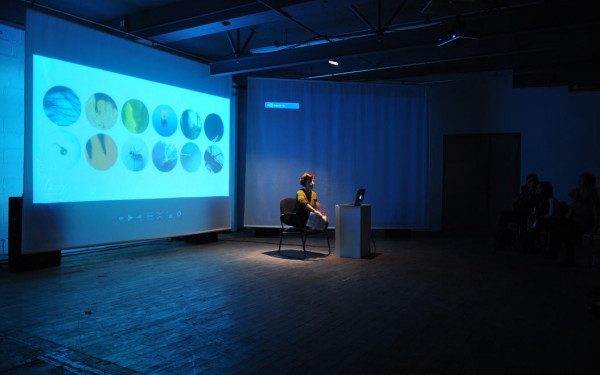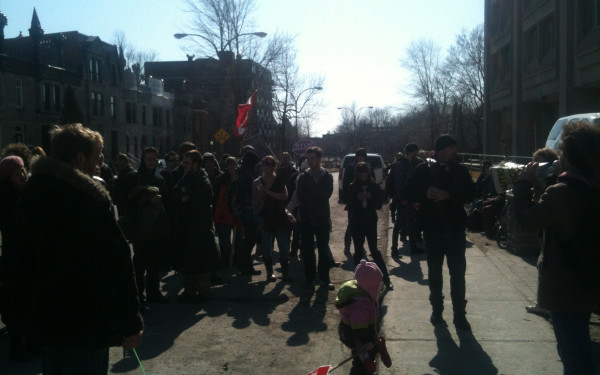Instrumental Emotions
New Exhibit ‘Swarming Emotional Pianos’ Fuses Emotions, Music and Robots
Of all the ways an artist can express emotion, cold and calculating robots might not seem like an obvious first choice—but robots playing music, stimulated by pure human biofeedback, is a different story.
Erin Gee, an artist-in-residence at Eastern Bloc currently pursuing an MFA at Concordia, is interested in using raw human emotion and transferring it to robots in order to make them play music. The music played will depend on the emotions felt by the actor connected to the robots, conveyed through a series of sensors.
“I’m working towards creating a fleet of mobile musical instruments that are kind of improvisational in a sense, but improvised by feeding them emotions,” she said.
Gee’s exhibit at Eastern Bloc looks like something out of a science fiction film. Actor Matt Keyes lies on a white box with a mess of wires attached to his fingers, as if being put through a lie detector test. The wires measure Keyes’s blood flow levels, heart rate and sweat levels, the fluctuations of which are visible on Gee’s screen. The data of the constantly changing emotions is fed into the robots to make them play.
“I have a plan for a sequencer that takes incoming data and will be able to play major or minor scales depending on [the actor’s] fight or flight reflex, which is demonstrated by the BDP, or how much his blood is flowing,” Gee explained.
“The actual length of the phrase can be determined by the breath […] and the complexity of the chord is determined by the sweat levels.”
Perfecting the Method
In order to get the strongest emotional response for her data, Gee decided to collaborate with method actors. Although an interactive experience could be an intriguing experiment, she explained that in order for the robots’ performances to reach their maximum potential, the person hooked up to them must be firmly in control of what they’re feeling.
“I was interested in working with method actors because method actors can actually control their emotions in a really fine, interesting way,” she said.
“So I’m not really as interested in this idea of people coming into a gallery and hooking themselves up, because it’s kind of like giving a cello to a total amateur and expecting it to be interesting. I’m setting up this alternative techno chamber music situation where you come and you watch the expert play their emotions.”
A method actor is not just interested in showing a particular emotion but in actually feeling it—a method used by famous actors like Daniel Day-Lewis and Dustin Hoffman— which requires much practice and discipline.
Keyes said that this type of work is much different than what he normally does on stage or on film. When on stage, he has the freedom to move around, to express anger through violent movements or fear through a physical cowering. In Gee’s project, however, he is lying down hooked up to wires.
“I’m constrained in my movements,” he said. “My preparation is usually much more physical to get myself in that state where I need to be, whereas this is all imagination. Usually it’s a combination of a bunch of different things but this is one specific thing.”
_(1)_900_600_90.jpg)
Musical Marionettes
Through “Swarming Emotional Pianos,” presented by Innovations en concert, Gee will be displaying where she stands at the end of her residency. It is not the completed final work, however, which will be shown this June at the international digital arts festival Elektra.
“My demonstration will kind of be like part art presentation, part science discussion about what happens to your body when you get emotional. It’s a portfolio of my research in a robot show,” she said.
Gee’s robots will be set up in a semi-circle with lights and automated hammers, which allow them to hit bells of different tones. There will also be a projection of the actor as he moves through his emotions so the audience is able to see the relationship with the robot’s music.
Although there is a connection between the emotions and the music, Gee said the sound won’t necessarily remind the audience of the associated feeling.
“I’m not really interested in unlocking film scores. I think that people have to come to this prepared to hear music, but it’s not like you’re going to say, ‘Oh, I hear the happiness now.’ You’re going to be listening to what his body’s doing, what his sweat’s doing, what his breathing’s doing. That’s not going to sound like John Williams,” she said.
“I’m working within my means to make it as musical as possible, but that doesn’t mean it’s going to be mega reflective.”
Swarming Emotional Pianos // March 27 to March 30 // Eastern Bloc (7240 Clark St.) // 6 p.m. Thursday, 12 p.m. to 5 p.m. Friday, Saturday and Sunday // Free admission

_900_529_90.jpg)



_600_375_90_s_c1.jpeg)
_600_375_90_s_c1.jpg)